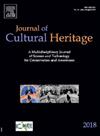Comparative study of silk residue extraction agents: Evaluating efficiency and investigating structural impact
IF 3.5
2区 综合性期刊
0 ARCHAEOLOGY
引用次数: 0
Abstract
This paper investigates the effectiveness of five different types of extractants for unearthed silk fabric residues. Residual proteins are extracted from non-aged and thermally-aged samples, and the extraction efficiencies are quantified by the bicinchoninic acid (BCA) method. Multivariate analysis of variance (MANOVA) is used for data processing, and sodium dodecyl sulfate - polyacrylamide gel electrophoresis (SDS-PAGE), ultraviolet-visible (UV-vis) absorption spectroscopy, and circular dichroism (CD) spectroscopy are adopted to characterize the influence of the extraction process on the protein structure. The results show that the extraction efficiency of the calcium-alcohol solution for all samples is significantly higher than that of the other four extractants. With longer aging time, the extraction efficiency of each extractant becomes lower, with copper-ethylenediamine (CED) being the least affected by aging. Furthermore, the lithium bromide (LiBr) and 1-allyl-3-methylimidazolium chloride (AmimCl) extraction processes exhibit the least effect on the molecular weight of the residual proteins in the non-aged samples. With increasing aging time, the influence of each extractant on the molecular weight of the residual proteins tends to be the same. The extraction process with calcium-alcohol solution retains more aromatic amino acid residues and yields proteins with a higher percentage of α-helic and random coil conformations. Therefore, it is more advantageous to use calcium-alcohol solution as an extractant for unearthed silk fabric residues.
丝渣提取剂的比较研究:评估效率和调查结构影响
本文研究了五种不同类型的萃取剂对出土丝织品残留物的有效性。从非老化和热老化样品中提取残留蛋白质,并采用双喹啉酸(BCA)法对提取效率进行量化。数据处理采用多变量方差分析(MANOVA),并采用十二烷基硫酸钠-聚丙烯酰胺凝胶电泳(SDS-PAGE)、紫外-可见(UV-vis)吸收光谱和圆二色性(CD)光谱来表征提取过程对蛋白质结构的影响。结果表明,钙-醇溶液对所有样品的萃取效率都明显高于其他四种萃取剂。随着老化时间的延长,每种萃取剂的萃取效率都会降低,其中铜-乙二胺(CED)受老化的影响最小。此外,溴化锂(LiBr)和1-烯丙基-3-甲基氯化咪唑(AmimCl)萃取过程对未老化样品中残留蛋白质分子量的影响最小。随着老化时间的延长,每种萃取剂对残留蛋白质分子量的影响趋于相同。钙-醇溶液提取过程保留了更多的芳香族氨基酸残基,得到的蛋白质具有更高比例的α-螺旋和无规线圈构象。因此,使用钙-醇溶液作为出土丝织品残留物的提取剂更为有利。
本文章由计算机程序翻译,如有差异,请以英文原文为准。
求助全文
约1分钟内获得全文
求助全文
来源期刊

Journal of Cultural Heritage
综合性期刊-材料科学:综合
CiteScore
6.80
自引率
9.70%
发文量
166
审稿时长
52 days
期刊介绍:
The Journal of Cultural Heritage publishes original papers which comprise previously unpublished data and present innovative methods concerning all aspects of science and technology of cultural heritage as well as interpretation and theoretical issues related to preservation.
 求助内容:
求助内容: 应助结果提醒方式:
应助结果提醒方式:


